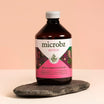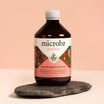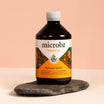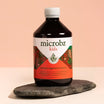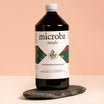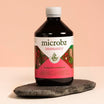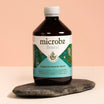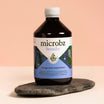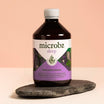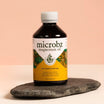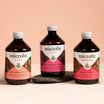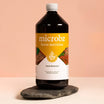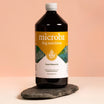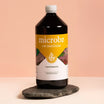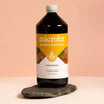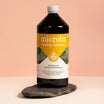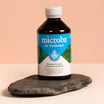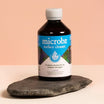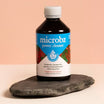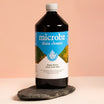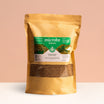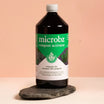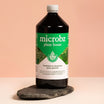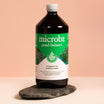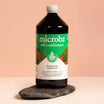Did you know that microbes are the invisible architects of life on Earth?
From the soil beneath our feet to the oceans that cover our planet, microbes are quietly shaping the conditions for life to flourish. While most of us are familiar with the term biodiversity, fewer people realise that microbial diversity—the richness and variety of microscopic life forms—is what makes biodiversity possible in the first place.
We have witnessed this first hand. Since the 2000s we have only been using probiotics in our gardens, meadows and fields.
The first thing we noticed was the increase in worm castings, a great sign of good soil. They show that there is plenty of microscopic life. Earthworms thrive and in turn add nutrients and aerate the soil. Around 10 worms per cubic foot is a good number to aim for.
And worms are a favourite food for birds. We’ve taken part in the RSPB’s Big Garden Birdwatch for nearly five years and the number of robins, blackbirds, finches and other common birds is growing. We’ve also counted more song thrush, linnets and skylarks which are declining species.
Then the diversity of the wildflowers really exploded; more wild orchids appeared over the
last few years. They are great bioindicators of a healthy, diverse ecosystem. We see bee orchids and early purple, and common spotted meadow orchids dotted around. There’s knapweed, musk mallow, ragged robin, red campion, daisies, yellow rattle, cowslips – and so much more precious variety.

We regularly see grass snakes, frogs, toads, and dragonflies – all more indicators of biodiversity and environmental health. As well as newts and salamanders; look at the protected Great Crested Newt who visited our doorstep one evening!

Here are five powerful ways microbes support biodiversity, backed by the latest scientific research
1. Microbes drive the ecosystems that all life depends on
Microbial communities are the engine rooms of Earth’s ecosystems. Soil microbes decompose organic matter, fix nitrogen, and recycle nutrients, enabling plants to grow—which in turn feed herbivores, predators, and entire food webs.
A 2023 study published in Nature found that higher microbial diversity significantly enhances ecosystem multifunctionality, including nutrient cycling, carbon storage, and plant productivity across global drylands. These ecosystem functions are essential for maintaining life as we know it.
2. Diverse microbes support healthy plants and animals
Healthy soils teeming with microbes help plants grow stronger, resist disease, and tolerate stress. The more diverse the microbial life in the soil, the more resilient and productive the plant community becomes.
A 2023 paper in Microbiome demonstrated that increasing the diversity of soil microbes improved plant biomass and reduced pathogen load, showing that microbial richness can directly support both plant health and species coexistence.
3. Microbes working together in symbiosis enable animals and humans to live well
Microbes live in symbiotic relationships with virtually all animals, including humans. They assist in digestion, regulate immune responses, and even influence behaviour and mood.
Without these relationships, complex organisms, including many species critical to ecosystems, couldn’t survive.
The loss of microbes for bigger animals can lead to the collapse of species or entire food chains.
A 2023 review in Trends in Ecology & Evolution found that microbes that live inside humans and other bigger animals contribute to host adaptability, enabling species to better respond to environmental change, boosting ecosystem resilience and overall biodiversity.
4. Microbes complete the cycle of life and regeneration
When an animal or plant dies, microbes take over the essential task of breaking down that life form and returning it to the Earth. Without these microbes working to decompose, ecosystems would be overrun by waste and death. But thanks to their diversity and efficiency, microbes ensure that all organic matter is recycled into new life.
You could say death is not the end – it is only the beginning of a process where microbes return nutrients to the soil. One dead animal can support a whole pop-up food web of microbes, soil fauna and arthropods that make their living off carcasses. Read more in this blog.
5. Restoring microbial diversity rebuilds native biodiversity in the UK
Across the UK, efforts to restore biodiversity—such as rewilding projects—are increasingly recognising the foundational role of soil microbial health. At sites like Knepp Estate in West Sussex, where natural grazing has been reintroduced, scientists have observed improved soil microbiome diversity.
This microbial recovery correlates with the return of wildflowers, insects, birds, and mammals that had previously disappeared.
A 2023 DEFRA soil health report states that “Soil is one of the world’s most complex ecosystems, providing a habitat for the millions of microbes, invertebrates and other biodiversity”
If we’re serious about protecting biodiversity, we must look below the surface—literally.
The microscopic world of bacteria, fungi, archaea, and other microbes is not just part of life; it’s the beginning of life. By nurturing microbes in soil, water, and even our own bodies, we help protect the balance of nature at every level.
We have witnessed this as a family, and the joy and wonder that has come with bringing back such diverse nature is something we want to help more people to do.
Do you want to be part of that change?
Explore our soil-based probiotics that support both your health and the planet’s.


